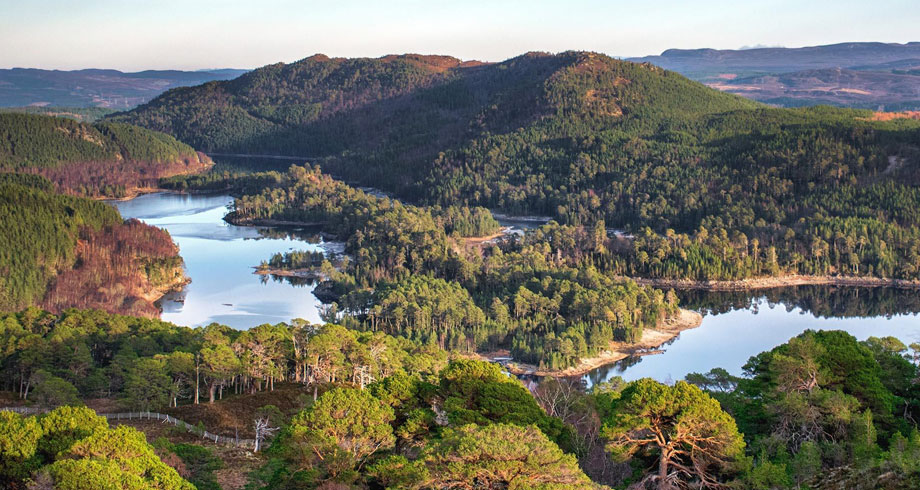

Scots pine trees are the only native pine tree in Scotland, and one of only three species of native conifer. It’s an evergreen tree with needle shaped leaves which are present year round. They have a scaly orange-brown bark that develops fissures with age, and mature trees grow to a height of 35m. It can live for up to 700 years, and was crowned Scotland’s national tree in 2014. It is commonly grown for timber, and produces timber that is pale reddish-brown with distinct rings.
Once widespread across Scotland, the Scots pine is now predominantly found in the Scottish Highlands where there have been extensive planting and rewilding programmes to reestablish historic forests. In the Tayside region, it is estimated that 20% of forest is inhabited by Scots pine. It is considered a pioneer species of tree, and is able to thrive in and regenerate poor soils. Outside Scotland, the Scots pine has an extensive natural range and can be found across Northern Europe.

Scots pine has a pale reddish-brown hue with distinct rings. It’s one of the strongest softwoods available, and is light and easy to work with. It’s not a naturally durable wood, but it is easily treated and takes preservatives well which increases the longevity significantly.
The timber from Scots pine is commonly used as a building and construction material, particularly for fencing. Around half of the Scots pine that is harvested in northern Scotland is processed into wood panels such as OSB as there is a large local manufacturing presence. It is also a popular material for making furniture, and can be used for bespoke joinery.
The bark from Scots pine is considered to be a low value material and is mostly used in gardens, but there is potential for it to be used as an insulation material and it has compared well with other more commonly used materials.
On a smaller scale, pine cones can be used as a natural dye for fabric and wool and produces colours ranging from brown to pale pink. They can also be dried and used as kindling for fires.

In the past, Scots pine was commonly used to manufacture telephone poles and ships’ masts, and was tapped and cut into to produce resin and tar. The resin was traditionally used to make turpentine but the vast majority of turpentine is now produced using other methods, although some trees may still be tapped in small quantities for this purpose.
Scots pine is the second most abundant conifer growing in the UK, and the only native conifer species grown for timber. It is forecast that Scots pine will account for 10% of Britain’s softwood supply over the next 50 years, and it’s predicted that it will reach peak production in 2036 thanks to the extensive planting that took place in the 1950s and 1960s. The majority of Scots pine timber in Britain is grown in Scotland, and this is set to increase in the future. Most of the timber is grown in the northeast of the country but can be found across Scotland in smaller quantities. In Tayside, the Craigvinean forest is one of Scotland’s oldest managed forests and an important timber production forest, which produces Scots pine timber amongst others.
Timber is one of the only renewable construction and building materials, and a resource that can be replenished and expanded through sustainable forestry and woodland management. When the wood reaches the end of its life cycle it can be reprocessed as wood chip, or used as biomass for energy generation.
Growing trees in carefully managed forests is not only a sustainable way to produce building materials, it also provides a habitat for wildlife, contributes to the Scottish economy, and is a valuable outdoor resource for people living in the country as well as being a tourist attraction.
McLean, Paul. “Wood properties and uses of Scots pine in Britain”. Forest Research,https://www.forestresearch.gov.uk/research/wood-properties-and-uses-scots-pine-britain/. Forestry Commission, 2019. Accessed 28 January 2021.
“Tay Forest District. Strategic Plan 2009 – 2013”. Forestry Commission Scotland,https://scotland.forestry.gov.uk/images/corporate/pdf/TayPlanPDF.pdf. Accessed 28 January 2021.
“A-Z of British Trees: Scots Pine”. Woodland Trust,https://www.woodlandtrust.org.uk/trees-woods-and-wildlife/british-trees/a-z-of-british-trees/scots-pine/. Accessed 28 January 2021.
“Scots pine”. Forestry and Land Scotland,https://forestryandland.gov.scot/learn/trees/scots-pine. Accessed 28 January 2021.
Architecture & Design Scotland. “Scots Pine”, Material Considerations: A Library of Sustainable Building Materials,https://materials.ads.org.uk/scots-pine/. Accessed 28 January 2021.
Whiting, Kate. “This Scottish forest is both a home for wildlife and a boost for the local economy.” World Economic Forum,https://www.weforum.org/agenda/2019/11/scottish-forest-craigvinean-home-for-wildlife-and-boosts-local-economy/. Accessed 28 January 2021.
Tayside Biodiversity Partnership. “Woodland Ecosystems”. Tayside Local Biodiversity Action Plan 2016 – 2026,https://www.taysidebiodiversity.co.uk/wp-content/uploads/2016/08/Tayside-LBAP-report-Woodland.pdf. Accessed 28 January 2021.
Marjo. “Natural Dyeing: Pine Cones”. The Easy Blues, https://theeasyblues.wordpress.com/2020/09/02/natural-dyeing-pine-cones/. Accessed 28 January 2021.